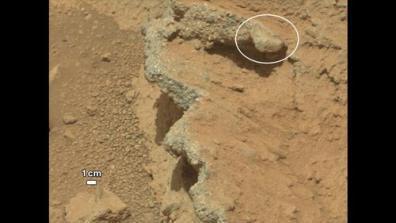Evidence of Ancient Streambed Found on Mars
 More news from the Red Planet! At a press conference held just yesterday, members of the Mars Science Laboratory announced that Curiosity discovered some interesting gravel patterns in the Gale Crater which would seem to indicate that water once flowed there. What more, according to William Dietrich (Curiosity’s co-investigator from the University of California, Berkeley) the water would have been flowing for some time.
More news from the Red Planet! At a press conference held just yesterday, members of the Mars Science Laboratory announced that Curiosity discovered some interesting gravel patterns in the Gale Crater which would seem to indicate that water once flowed there. What more, according to William Dietrich (Curiosity’s co-investigator from the University of California, Berkeley) the water would have been flowing for some time.
“Too many things that point away from a single burst event,” he said in the press statement. “I’m comfortable to argue that it is beyond the 1,000 year timescales, even though this is very early on in our findings.”
Specifically, what Curiosity found was outcroppings of layered rock that are the result of multiple deposits of gravel, which the science team claims could not have been laid by any other naturally occurring source, such as wind. What’s more, the sizes and shapes of stones offer clues to the speed and distance of a long-ago stream’s flow. Although initially classifying this as a “surprise”, the team inevitably claimed that they weren’t too surprised by the finding.
 The location of the site lies between the north rim of the Gale Crater and the base of Aeolis Mons (aka. Mount Sharp), a mountain inside the crater. To the north of the crater, a channel named Peace Vallis feeds into the alluvial fan, where the abundance of channels between the rim and conglomerate suggests the presence of flowing water over a long period of time.
The location of the site lies between the north rim of the Gale Crater and the base of Aeolis Mons (aka. Mount Sharp), a mountain inside the crater. To the north of the crater, a channel named Peace Vallis feeds into the alluvial fan, where the abundance of channels between the rim and conglomerate suggests the presence of flowing water over a long period of time.
For some time, scientists have speculated about the existence of ancient rivers on Mars, based solely on observations from afar. In fact, the “canals of Mars”, as they were often known, have remained a source of inspiration for astronomers and fired the public imagination. The notion that there might be life on the Red Planet inevitably led some to suggest that there was such a thing as a Martian race that was responsible for their creation.
This, in turn, has led to generations of science fiction and storytelling, with images of little Martian men invading Earth in their terrible war machines (a la War of the Worlds) or as benevolent psychic begins who succumbed to disease and the onset of human colonization (i.e. The Martian Chronicles). Naturally, these fantastic notions died when it became known that the Martian surface is all but lifeless. However, evidence that Mars was once capable of supporting life remains; and thanks to Curiosity, continues to grow.
Stay tuned for more news from Curiosity! As of yesterday, it moved on from the Garland Crater and began its longest journey yet towards the Glenelg area, where it will begin taking soil samples and performing test drills. The goal here will be to find samples of preserved organic carbon, another step in the long mission to determine whether Mars really did support life in the past. Exciting times!





